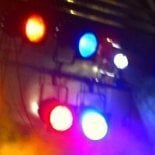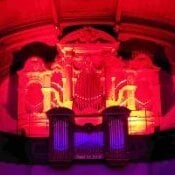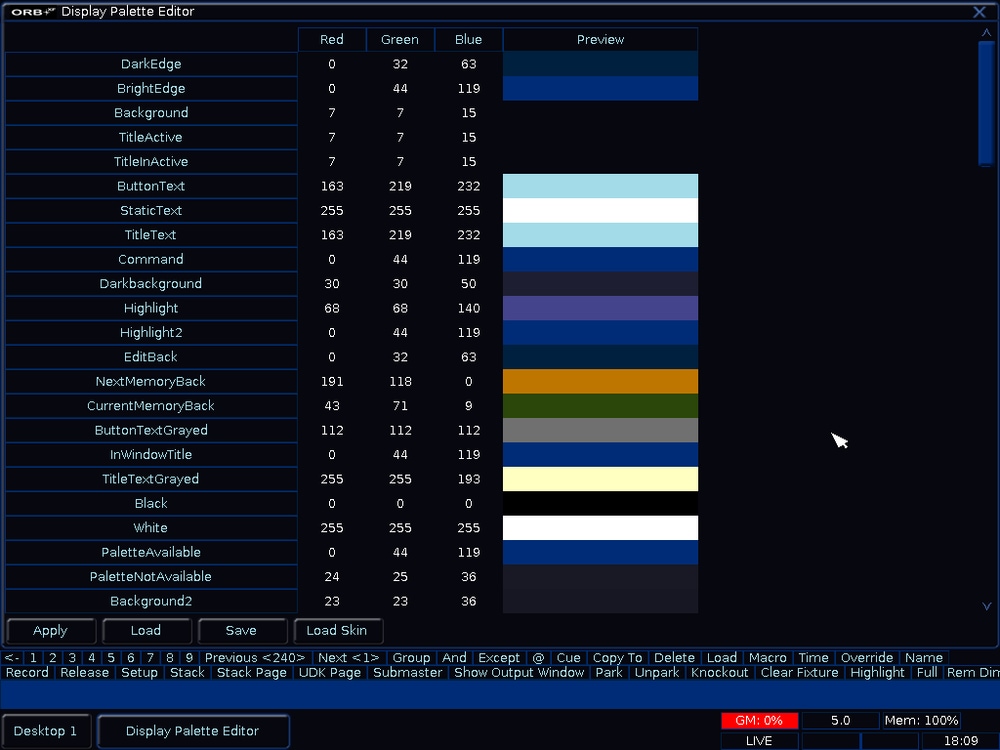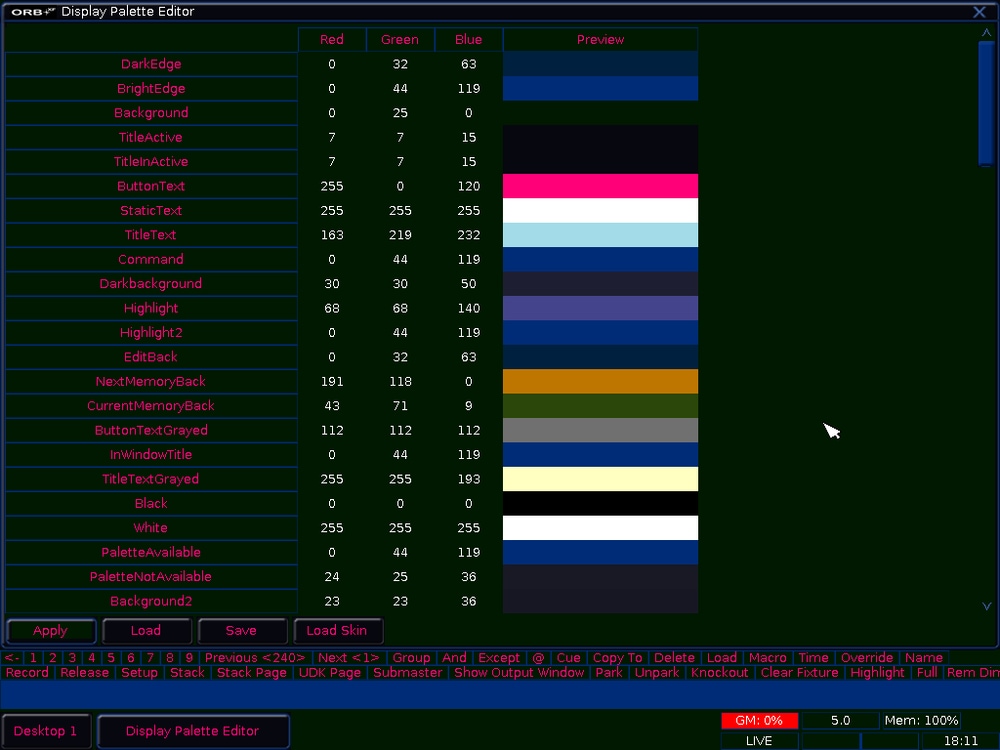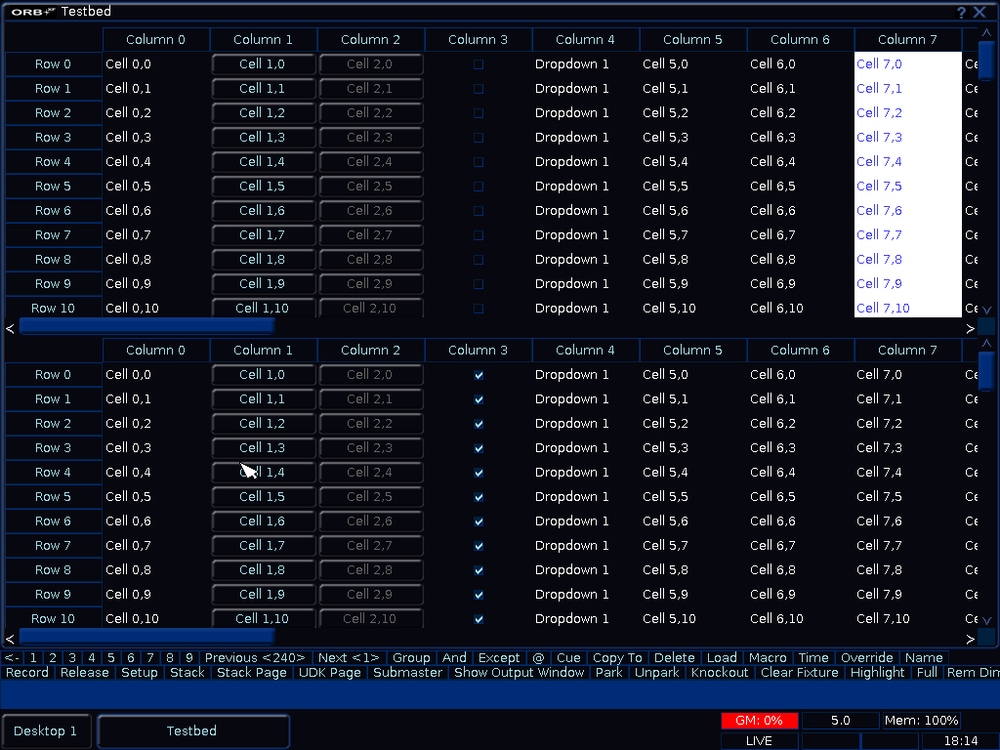All Activity
- Last week
-
MHSNetSup joined the community
- Earlier
-
pmiller057 joined the community
-
I have long been asking for Exclusive Playbacks for the very same reason. This is what Edward Smith sent me back in March 2023: Exclusive Playback" faders are currently assigned to ZerOS 8 on our roadmap. Please note that this could move if our priorities change. If a playback is configured as exclusive, this would prevent it from being recorded into cues, even if recording with SmartTag.
-
Archie D started following Display tweaking
-
The ability to change views within the Output Window between 20 or 24 fixtures is possible with channel width located in 'Window Setup', but only for Solution / XL, Leapfrog 48/96, Orb, OrbXF and SCD Server Pro. This button is on the top bar of the Output Window, but unfortunately (as far as I can see), it is not available for FLX, FLX S or ZerOS Server. In response to your original question, you may be thinking of the 'Hide Unpatched' option within this popup window that will stop any unpatched fixtures being shown in the Output Window perhaps? See below:
-
I did check that out just to make sure but that just stops the desk scrolling beyond allocated blocks of channels or scenes on the page button, something I use anyway as it is useful.
-
kgallen started following Protect Fixture from being recorded? and Display tweaking
-
Is it related to ‘Hide Fader Pages’ here? https://www.zero88.com/manuals/zeros/setup/settings/operational
-
I vaguely remember being able to adjust a setting so that the fixture level window could be set to show greyed out missing fixtures in order to keep the numbers in alignment with the faders. However I just made a new patch for a new venue and any skipped fixtures are just skipped, e.g. if there is no fixture 11 it displays 10 next to 12. If I load my regular (FLX) show into the FLX-S which doesn't have fixture 11 it is shown greyed out between 10 and 12. I've searched the online manual for likely words and gone through the menus but no luck. I remember an older prompt on earlier ZEROS for leapfrog to display 20 or 24 fixtures but that was a while back. Can anyone nudge me in the right direction or is it more of a hack? Cheers, Ian
-
I think my issue is mainly when updating a cue(s) during a rehearsal or during a run, I naturally have the haze machine running, so it inadvertently gets recorded into the cue. A good reminder about the 'Remove' feature for the odd cue or two, but I've generally found the delete fixture route catches all my errors if its been a big update session!
-
Archie D changed their profile photo
-
@kgallen @scottydog75 Well yes, but in a show situation, when you discover your hazer (or anything else) has been caught in cues, you can quickly set up an inhibit to get you through the performance.
-
I was going to suggest inhibit but I think that’s more a sticking plaster over the issue rather than a proper approach that David described above.
-
Davidmk started following Protect Fixture from being recorded?
-
If you are operating with tracking options set to "Cue Only" or you have "Snapshot" enabled when you record then you have effectively told the desk to record everything. See manual here and here. In the Record Options, "SmartTag" enabled could record the hazer - if you changed one or more of its values in the programmer. For full control of what gets recorded you need SmartTag off. You can then select "Tagged Fixtures" which will record every fixture that has been changed or "Selected Fixtures" wich only records the currently selected Fixtures. See manual here. Cue Only, Snapshot & SmartTag all let the desk decide what to record, turning all of them off makes you decide but then you need to be sure you have included everything you want. Tagged Fixtures will generally get that right, with Selected Fixtures there is a risk that you will select a fixture, change it, de-select it, select another and change it then record - in this case only the 2nd fixture gets recorded. Essentially, the desk will do what you tell it but you need to understand what you've told it. There are videos in the linked manual references, these might help. To remove your hazer (or anything else) from a cue, select it, press Home then Update and select Remove. Hope that helps.
-
Is anyone aware if there is a way to always exclude a fixture from being recorded into a cue stack? I keep accidently recording my haze machine into my main PB, which can be resolved by deleting and re-patching the hazer, but feel like there must be a better way? Cheers
-
Hello again, so we've hit a new problem while a small concert was going on in our school. Another "crew member" created a cue without any effects, just a static cue with some positions changed. To be more precise it was Cue 50/1. Now, she made a cue on another playback. Basically she wanted 50/1 to go to 27/2 - 27/2 is a cue with effects, mainly rotating wash heads and a rainbow color. Every time we copied the Cue on the third page to the one on the second, the 50/1 also started to have the same effects, effectively copying the other cues contents. Why is that happening? My only suspicion is that the showfile was originally created in the earlier software version without pages 3 and 4. Can that be a software error or are we just missing something. Thanks in advance, Jan
-
Stuart McIntyre joined the community
-
Davidmk started following Blind edit without impact from life scene
-
From the manual... Cue only means that tracking options will not be available within the Record and Update windows. Cues are programmed with a full capture of the stage output to ensure what you see on stage is exactly what is programmed, and exactly what will be played back when you replay the cue. I suspect this is the reason why you are saving the whole stage output. Try it with cue only off - this should get you the record options, selected fixtures might be useful.
- 1 reply
-
- 1
-

-
Kauz started following Is 8.0 really buggy? and Blind edit without impact from life scene
-
Hi, I would like to create a que from scratch and save it to a playback while another scene (from another playback) is life on stage. However, even if I am creating the cue in "Blind" mode, the channels of the life scene are saved too. I should mention that I have set the cosole to "Cue Only" recording. Is there a way to avoid any impact from the life scene when creating a cue in "Blind" mode?
-
@SimonH One of those occasions where I am glad to be wrong 😀
-
The show file was fine as it loaded onto my spare desk ok. I've reloaded the software now and all seems to be back again. Thanks
-

Control fixtures Intensity & Colour via a custom Program
MD1125 replied to MD1125's topic in FLX S24 & FLX S48
Well yeah, under 2.3 of the Monitor EULA it states: "Licensee will not, nor will it permit others to, modify, adapt, translate, reverse engineer, decompile, or disassemble the Software or any component thereof (including the Documentation), or create derivative works based on the Software (including the Documentation), except to the extent such foregoing restriction is prohibited by applicable law." and under 5.12: "Licensee acknowledges that confidential aspects of the Software (including any proprietary source code) are a trade secret of Cooper Lighting Solutions UK Ltd., the disclosure of which would cause substantial harm to Cooper Lighting Solutions UK Ltd. that could not be remedied by the payment of damages alone. Accordingly, Cooper Lighting Solutions UK Ltd. will be entitled to preliminary and permanent injunctive and other equitable relief for any breach of this Section 5.12." In this case for example, sharing where this is: Would be allowed, because it kinda falls under intended use, but I think sharing real source code or "trade secrets" wouldn't. -
Control fixtures Intensity & Colour via a custom Program
Davidmk replied to MD1125's topic in FLX S24 & FLX S48
Based on a non-scientific appraisal of forum comments, I think you'd make yourselves very popular with the community (but probably not with official support) if you found a way to extract the patch from a show file. Something that could be loaded in a spreadsheet would be good. (I have a feeling that there is a prohibition on reverse engineering the software though) -
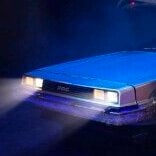
Control fixtures Intensity & Colour via a custom Program
Archie D replied to MD1125's topic in FLX S24 & FLX S48
I mean.. not to lead too far away from the post's original topic with my message below, but if we're on the topic of analysing ZerOS... relatively recently I loaded ZerOS up and had a play around. I'm not sure if it has been discussed before, but I discovered that ZerOS used to have (or still has - I just cannot seem to find it) a partial theme editor for the external monitor's UI appearance.. in newer versions it seems to have disappeared though. This was on ZerOS version 7.8.2.39, so that software version was released just nearing the end of 2016 and was the last available one for Frog 2. I also found a "Testbed" window, which was most definitely for development purposes of displaying cells, buttons, tickboxes, dropdowns, and other UI elements that need to be presented by the software. Below, I've attached three screenshots that I took today to show here. The first two relate to the "Display Palette Editor" (theme editor, one screenshot is the default view and the other is when I'd edited some colours such as the background to be green and button text to be pink) and "Testbed" for UI elements. P.S. admins - I apologise if sharing this isn't allowed for development reasons, please delete my post if that is the case Safety notice - if you somehow find this on your console (I won't say how I got these windows, to prevent any misuse of it or people potentially making mistakes) - I definitely don't recommend changing any values at all, because when resetting the desk, it won't reset these values. -
Control fixtures Intensity & Colour via a custom Program
Davidmk replied to MD1125's topic in FLX S24 & FLX S48
@Archie D @MD1125 You are out of my experience here. Nearest I've been was programming PDP11s 50yrs ago. No desire to return to that level of detail -

Control fixtures Intensity & Colour via a custom Program
Archie D replied to MD1125's topic in FLX S24 & FLX S48
@MD1125, thank you very much for sharing and outlining this. Analysing network traffic.. I wouldn't have figured that out straight off! That's really interesting to see how ZerOS handles inputs from the mobile apps. I recognise the Z88R part of the string - presumably meaning "Zero 88 Remote". When I opened some of the obfuscated files that ZerOS contains (built on a linux system), most begin with "Z88C" from what I remember, presumably meaning "Zero 88 Console", so I can see the links starting to form... -

Control fixtures Intensity & Colour via a custom Program
MD1125 replied to MD1125's topic in FLX S24 & FLX S48
I was just in general interested in how all of it works I guess. No direct purpose, just pure interest. Oh and regarding the theoretical direct string input: I was actually able, after some playing around, to fully emulate the traffic between the Monitor and FLX S24 by opening my own TCP connection to the FLX and then send the same strings it does from the Monitor App. From what I've looked at in the traffic it first sends a string to initialize, then one carrying the Password, and then you have (in theory) full control over the Keyboard. By sending these strings: "5a 38 38 52 01 00 00 00 1d 00 00 00 44 4b 65 79 00 00 00 00 00 0a 00 00 00 00 00 00 00", "5a 38 38 52 01 00 00 00 1d 00 00 00 44 4b 65 79 00 00 00 00 03 61 00 00 00 00 00 00 00", "5a 38 38 52 01 00 00 00 1d 00 00 00 44 4b 65 79 00 00 00 00 01 0a 00 00 00 00 00 00 00", You can emulate you typing an "@" on your keyboard, same goes for any other keys you might press, so by expanding this system you could (theoretically) make your own API I guess, just not directly for colour, although that would also work if you kinda pre-record where the mouse has to press. And as far as "debugging" these strings goes, they seem to be actually rather structured, example: First string for @ -> "5a 38 38 52 01 00 00 00 1d 00 00 00 44 4b 65 79 00 00 00 00 00 0a 00 00 00 00 00 00 00" Z 8 8 R D k e y Presumably key data "5a 38 38 52 01 00 00 00 1d 00 00 00 44 4b 65 79 00 00 00 00 03 61 00 00 00 00 00 00 00" -
Control fixtures Intensity & Colour via a custom Program
Davidmk replied to MD1125's topic in FLX S24 & FLX S48
@Archie D I'm not sure what the level of control @MD1125 described is for. It would be easier to get a long DMX cable and move the desk. I use OSC to get quick access to colours, positions, effects and other stuff when I'm busking. I record what I might want as cues in playbacks and send a go PB/cue by OSC from a screen next to the desk. I don't use it when programming the show file in the first place. -

Control fixtures Intensity & Colour via a custom Program
Archie D replied to MD1125's topic in FLX S24 & FLX S48
Ah, @Davidmk, I do apologise for posting over your post, the forum page didn't update for me showing your post when you posted it while I was writing mine. Archie -

Control fixtures Intensity & Colour via a custom Program
Archie D replied to MD1125's topic in FLX S24 & FLX S48
Hello @MD1125, Welcome to the Zero 88 forum. Yes, this is correct. The ZerOS Monitor and Remote apps rely directly on the console, therefore all processing when performing actions on the remote apps is done on the console itself, and rather not your own device apart from sending the x and y coordinates like you say. I believe this unfortunately won't be directly possible, as ZerOS only accepts communication to the console via the methods @kgallen outlined regarding MIDI and OSC, however the FLX S is unable to use MIDI as it doesn't have a physical port. This is correct as well, however I am going to highlight 'Macros' as a part of this. There are two types of Macros within ZerOS. Fixture Macros, and User Macros. Fixture Macros are available on the FLX S, but User Macros aren't. On the other hand, if you did have access to User Macros for example on a full size FLX (max 240 macros) or a Solution (max 400 macros), you could theoretically: Record -> Tap 'Macro' -> Select a macro to record to -> Keys -> Type the syntax commands you would like (Keys will also record presses such as 'Home') -> Tap 'Macro' again to stop recording -> Tap 'Clear' to clear the syntax line. If you use Solution for this, you need to instead tap the Macro's MFK to stop recording I think. Doing this is of course rather painful, and will only let you control specific fixtures at specific levels you have already programmed into the console, and if using the full size FLX it will eat into your macro count relatively quickly (max 240) depending on how you use this, but it will allow you to control the macro you have just programmed via the OSC protocol, which you could use in your own codebase as you wish to control the intensity levels of specific fixtures. For example, if I then programmed a macro via the following: Record -> Macro -> Macro 1 -> Keys -> '1 thru 10 Home' -> Macro I could then execute that exact combination of key presses on the console by firing a command over the OSC protocol: /zeros/macro/1 (if I recorded it as Macro 1). You could record singular colours using Macros as well. I am aware that you are on the FLX S, and that this unfortunately won't be possible for your console regarding User Macros, but I thought I would take the chance to share this information in case it is of use for the future for you (who knows...). It definitely isn't the best way of doing things, but it is a little workaround that I found to partially work. So, in answer to your question, you could fire 1 enter @100 enter, but just not on the FLX S. -
Control fixtures Intensity & Colour via a custom Program
Davidmk replied to MD1125's topic in FLX S24 & FLX S48
What do you actually want to achieve with this? Not in terms of what you would do if you were at the desk, more in terms of what it looks like on stage.
